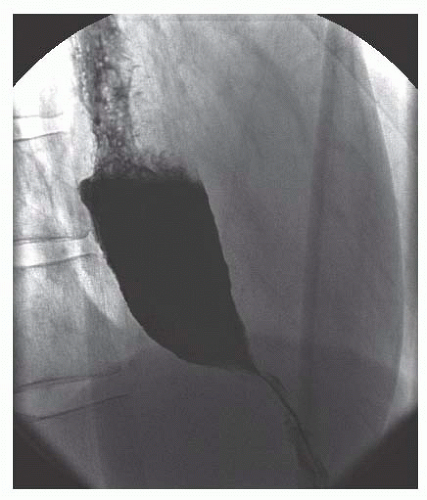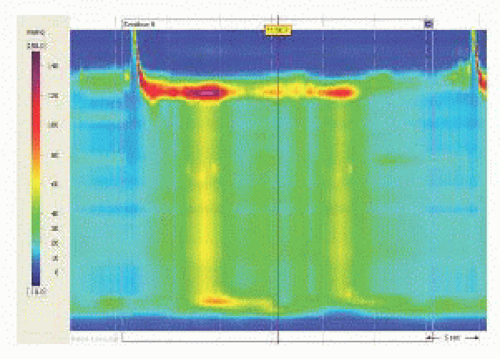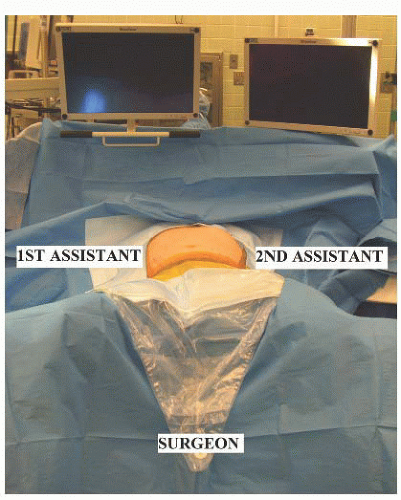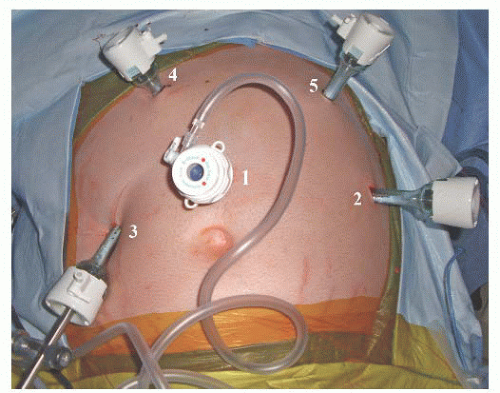Laparoscopic Heller Myotomy and Anterior Fundoplication for Esophageal Achalasia
Marco E. Allaix
Marco G. Patti
DEFINITION
Esophageal achalasia is a primary motility disorder characterized by lack of esophageal peristalsis and failure of the lower esophageal sphincter (LES) to relax properly in response to swallowing.
DIFFERENTIAL DIAGNOSIS
Benign strictures secondary to gastroesophageal reflux disease (GERD) and esophageal neoplasms may mimic the clinical presentation of achalasia.
An infiltrating tumor of the gastroesophageal junction can mimic not only the clinical and radiologic findings of achalasia but also the manometric profile. This condition, defined as “secondary achalasia” or “pseudoachalasia,” should be suspected and ruled out in patients older than 60 years of age, with recent onset of dysphagia (less than 6 months), and with excessive weight loss.1
PATIENT HISTORY AND PHYSICAL FINDINGS
Dysphagia is the main complaint, being reported by about 95% of patients. It is often for both solids and liquids. Most patients are able to maintain a stable weight due to changes made in their diet.
About 60% of patients experience regurgitation of undigested food. It occurs more frequently in the supine position and may lead to aspiration that in turn can cause respiratory symptoms, such as cough, hoarseness, wheezing, and episodes of pneumonia.2
Heartburn is present in about 40% of patients: It is due to stasis and fermentation of undigested food in the distal esophagus rather than due to gastroesophageal reflux (GER).
Esophageal distention can cause chest pain in up to 40% of patients, and it is usually experienced at the time of a meal.
IMAGING AND OTHER DIAGNOSTIC STUDIES
A thorough evaluation to establish the diagnosis should be performed in all patients with symptoms suggestive for achalasia.3 It consists of the following studies:
Upper endoscopy is usually the first test that is performed to rule out the presence of a mechanical obstruction secondary to a peptic stricture or cancer.
Barium swallow shows a narrowing at the level of the gastroesophageal junction (the so-called bird’s beak), slow esophageal emptying with an air-fluid level, and either absence of or tertiary contractions of the esophageal wall (FIG 1). It also defines the diameter and the axis of the esophagus (dilated and sigmoid in long-standing achalasia) and associated pathologic findings, including an epiphrenic diverticulum. The gastric air bubble is usually absent.

FIG 1 • Barium swallow: dilatation of the esophageal body, retained barium, and distal esophageal narrowing (bird’s beak).
Esophageal manometry is the gold standard for the diagnosis of achalasia. Lack of peristalsis and absent or incomplete LES relaxation in response to swallowing are the key criteria for the diagnosis. The LES is hypertensive in only about 50% of patients.3 Recently, a new classification of esophageal achalasia has been proposed based on high-resolution manometry (HRM): type I, classic, with minimal esophageal pressurization; type II, achalasia with panesophageal pressurization; and type III, achalasia with spasm (FIG 2).4

FIG 2 • High-resolution esophageal manometry: type II achalasia according to the Chicago classification.
Ambulatory pH monitoring is important in untreated patients when the diagnosis is uncertain in order to distinguish between GERD and achalasia. Postoperatively, ambulatory pH monitoring can be performed to rule out GER that is present in about 30% to 40% of cases after Heller myotomy and is often asymptomatic.5
SURGICAL MANAGEMENT
Preoperative Planning
A careful systematic evaluation and the tests described before should be performed in every patient before treatment.
Positioning
After induction of general endotracheal anesthesia, the patient is positioned supine in low lithotomy position with the lower extremities extended on stirrups, with knees flexed 20 to 30 degrees or straight if using a split-leg table.
To avoid sliding as a consequence of the steep reverse Trendelenburg position used during the procedure, a beanbag is inflated to create a “saddle” under the perineum.
Because increased abdominal pressure from pneumoperitoneum and the steep reverse Trendelenburg position decrease venous return, pneumatic compression stockings are always used as prophylaxis against deep venous thrombosis.
An orogastric tube is placed to keep the stomach decompressed during the procedure and it is removed before starting the myotomy.
A Foley catheter is inserted at the beginning of the operation and removed at the end.
The surgeon stands between the patient’s legs. The first and second assistants stand on the right and left side of the operating table (FIG 3).
TECHNIQUES
PLACEMENT OF PORTS
Five 10-mm trocars are used for the procedure (FIG 4).
The first incision is made in the midline 14 cm distal to the xiphoid process and a Veress needle is introduced into the peritoneal cavity. The peritoneal cavity is insufflated to a pressure of 15 mmHg. Subsequently, under direct vision, an optical port with a 0-degree scope (port 1) is placed. Once this port is placed, the 0-degree scope is replaced with a 30- degree scope and the other trocars are inserted under laparoscopic vision.
Port 2 is placed in the left midclavicular line at the same level of port 1. It is used by the assistant for traction on the gastroesophageal junction and as an instrument to take down the short gastric vessels.
Port 3 is placed in the right midclavicular line at the same level of the other two ports. A retractor is used through this port to lift the left lateral segment of the liver to expose the gastroesophageal junction. The retractor is held in place by a self-retaining system fixed to the operating table.
Ports 4 and 5 are placed under the right and left costal margins so that their axes and the camera form an angle of about 120 degrees. These ports are used by the operating surgeon.
The instrumentation necessary for the laparoscopic myotomy is reported in Table 1.
Table 1: Instrumentation for Laparoscopic Heller Myotomy and Partial Fundoplication
Stay updated, free articles. Join our Telegram channel
Full access? Get Clinical Tree
 Get Clinical Tree app for offline access
Get Clinical Tree app for offline access

|
|---|

